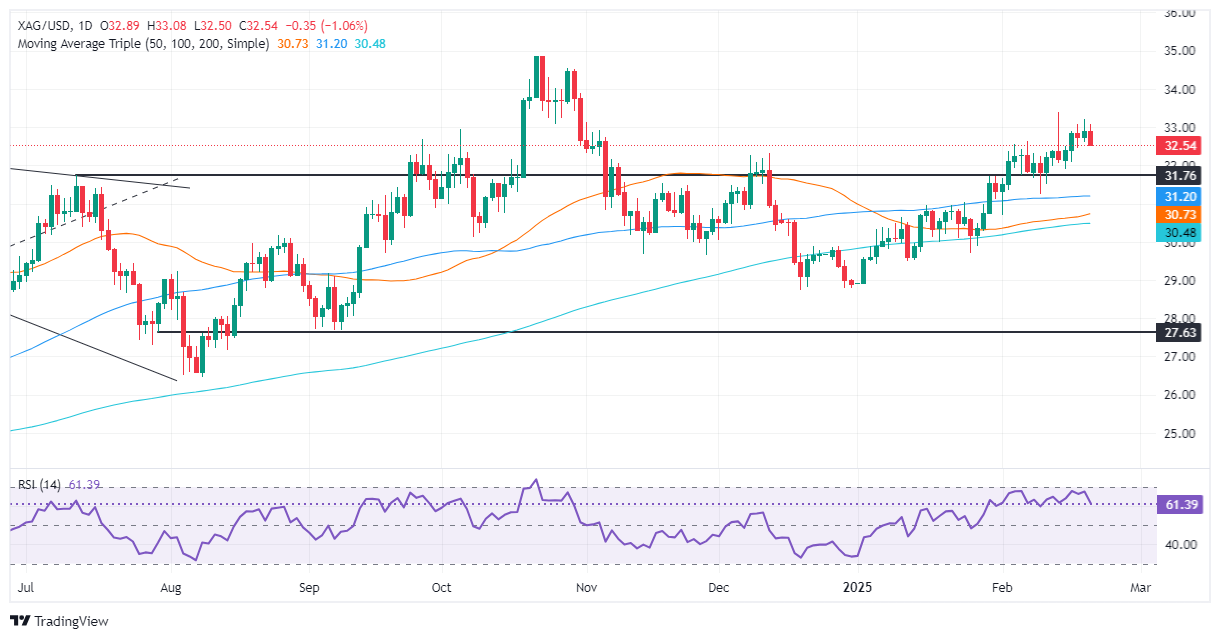Silver Price Forecast: XAG/USD slips 1.20% as bullish momentum fades below $33.00
- Silver retreats to $32.54 after failing to hold above key $33.00 level.
- RSI signals mixed momentum, with downside risks if $32.00 support breaks.
- Next resistance at $33.20, while key support lies at 100-day SMA near $31.12.
Silver's price retreats on Friday and fails to capitalize on falling US yields. According to the 10-year T-note, yields tumbled almost eight basis points to 4.431% at the time of writing. The XAG/USD trades at $32.54, down 1.20%.
XAG/USD Price Forecast: Technical outlook
XAG/USD’s uptrend remains in place, but failure to end the day/week above $33.00 exacerbated Silver’s plunge. Bullish momentum has faded, as depicted by a Relative Strength Index (RSI), which gives mixed signals. The RSI is bullish, but the slope is aiming downwards.
Buyers must clear the February 20 high at $33.20 for a bullish continuation. Once done, further upside Is seen, with the next resistance being the February 14 peak at $33.39 ahead of the $34.00 figure.
Conversely, if XAG/USD drops below $32.00, this would exert downward pressure on the precious metal. the first support would be the 100-day Simple Moving Average (SM) at 31.12, followed by the 50-day SMA and the 200-day SMA, each at 30.70 and 30.46.
XAG/USD Price Chart – Daily
Silver FAQs
Silver is a precious metal highly traded among investors. It has been historically used as a store of value and a medium of exchange. Although less popular than Gold, traders may turn to Silver to diversify their investment portfolio, for its intrinsic value or as a potential hedge during high-inflation periods. Investors can buy physical Silver, in coins or in bars, or trade it through vehicles such as Exchange Traded Funds, which track its price on international markets.
Silver prices can move due to a wide range of factors. Geopolitical instability or fears of a deep recession can make Silver price escalate due to its safe-haven status, although to a lesser extent than Gold's. As a yieldless asset, Silver tends to rise with lower interest rates. Its moves also depend on how the US Dollar (USD) behaves as the asset is priced in dollars (XAG/USD). A strong Dollar tends to keep the price of Silver at bay, whereas a weaker Dollar is likely to propel prices up. Other factors such as investment demand, mining supply – Silver is much more abundant than Gold – and recycling rates can also affect prices.
Silver is widely used in industry, particularly in sectors such as electronics or solar energy, as it has one of the highest electric conductivity of all metals – more than Copper and Gold. A surge in demand can increase prices, while a decline tends to lower them. Dynamics in the US, Chinese and Indian economies can also contribute to price swings: for the US and particularly China, their big industrial sectors use Silver in various processes; in India, consumers’ demand for the precious metal for jewellery also plays a key role in setting prices.
Silver prices tend to follow Gold's moves. When Gold prices rise, Silver typically follows suit, as their status as safe-haven assets is similar. The Gold/Silver ratio, which shows the number of ounces of Silver needed to equal the value of one ounce of Gold, may help to determine the relative valuation between both metals. Some investors may consider a high ratio as an indicator that Silver is undervalued, or Gold is overvalued. On the contrary, a low ratio might suggest that Gold is undervalued relative to Silver.
